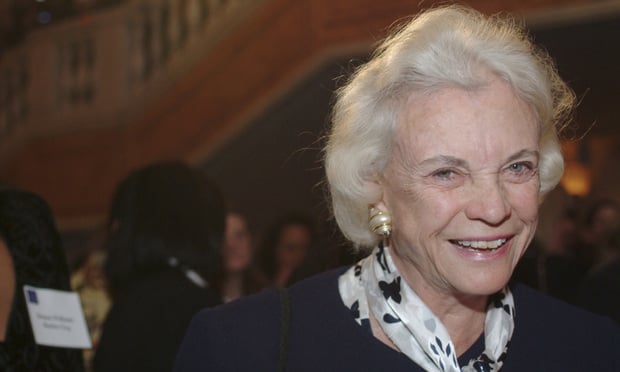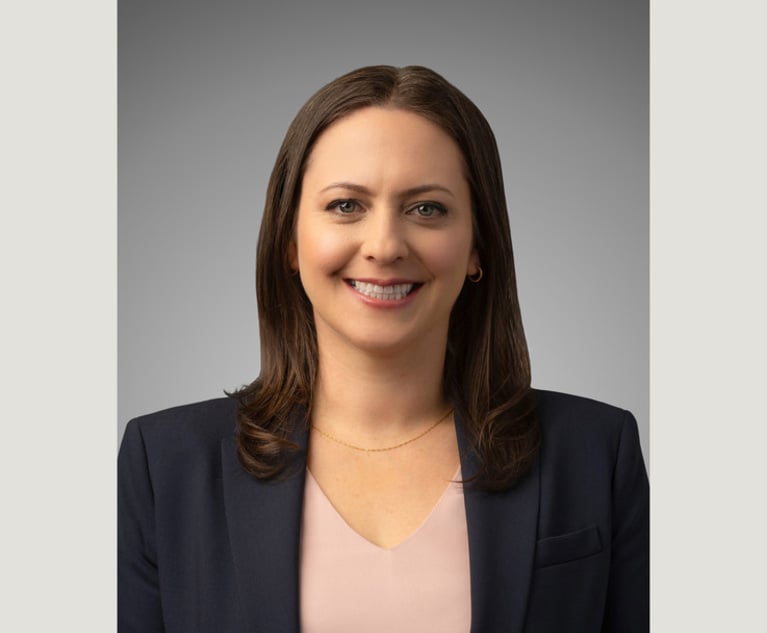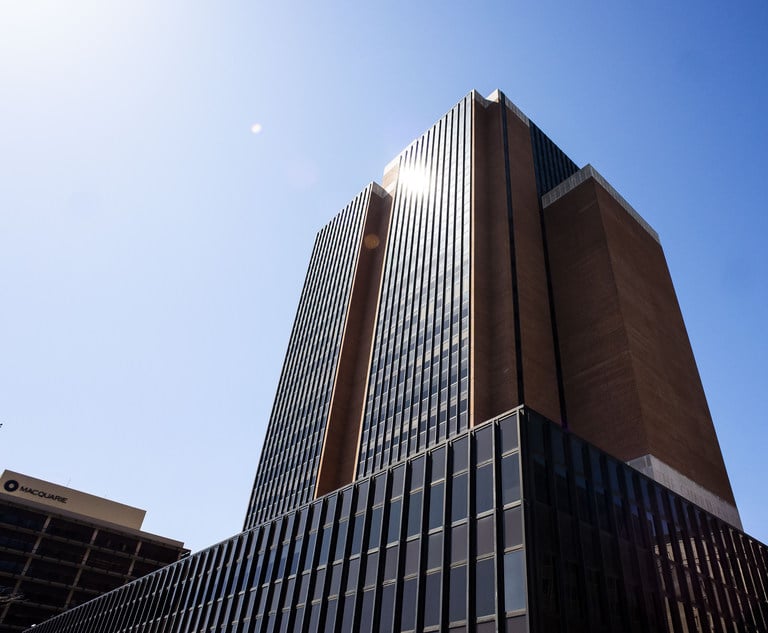O'Connor, Stepping Back From Public Life, Gave Her Chambers to Kennedy
With Justice Samuel Alito Jr. moving up to Anthony Kennedy's chambers, Brett Kavanaugh took Alito's. But where would Kennedy go?
October 23, 2018 at 12:30 PM
4 minute read
 Sandra Day O'Connor receives the Lifetime Achievement Award from the National Association of Women Judges in 2006. Photo by Diego M. Radzinschi / NLJ
Sandra Day O'Connor receives the Lifetime Achievement Award from the National Association of Women Judges in 2006. Photo by Diego M. Radzinschi / NLJ
Before announcing her withdrawal from public life on Tuesday, retired Supreme Court Justice Sandra Day O'Connor gave her newly retired colleague Anthony Kennedy a gift of sorts: her chambers. It was a gesture that affirmed the camaraderie and traditions that keep the court collegial, most of the time.
When Kennedy officially retired on July 31, he left behind one of the most coveted offices or chambers of the court, with a stunning view of the U.S. Capitol across the street. Its location enabled him to watch protesters outside, once leading him to utter this memorable if cryptic statement as abortion rights activists demonstrated in 1992: “Sometimes you don't know if you're Caesar about to cross the Rubicon or Captain Queeg cutting your own tow line.”
Once a justice cuts his or her own ties by retirement, the new justice replacing the retiree does not automatically inherit the predecessor's quarters.
The vacated chamber is offered up to sitting justices, in order of seniority. Justice Samuel Alito Jr. now occupies Kennedy's chambers, which likely means that three associate justices with more seniority than Alito—Clarence Thomas, Ruth Bader Ginsburg and Stephen Breyer—said no thanks, for reasons that can only be guessed at.
With Alito moving up to Kennedy's chambers, Brett Kavanaugh took Alito's. But where would Kennedy go? Retired justices are entitled to an office, though sometimes a smaller one; they have only one law clerk instead of the four clerks allotted to sitting justices.
O'Connor came to the rescue, turning over her retiree chambers to Kennedy, the court public information office reported on Monday. The court's first female justice had moved to different quarters after she retired in 2006 and Alito, her successor, moved in to her former chambers, completing the circle.
 Anthony Kennedy and Sandra Day O'Connor at a groundbreaking ceremony for the underground Supreme Court annex in June 2003. Credit: Stacey Cramp.
Anthony Kennedy and Sandra Day O'Connor at a groundbreaking ceremony for the underground Supreme Court annex in June 2003. Credit: Stacey Cramp.O'Connor's move was a melancholy sign of her health issues at age 88. But in a way, it also symbolized the devotion justices have to their colleagues in retirement, even after decades of working together.
The Thurgood Marshall Federal Judiciary Building is a few blocks away from the Supreme Court, and when it opened in 1992, two or three offices were allotted for retired Supreme Court justices, on the theory that there might not be enough space for retirees at the court itself.
But that option was never popular, and the last retired justice with an office at the Marshall building was Byron White, who died in 2002. Justices simply did not want to leave the welcoming surroundings of the Supreme Court community.
The Supreme Court now has four living retired justices, an unusually large number. Retired Justice John Paul Stevens still has chambers at the Supreme Court as does David Souter, who also has an office in his home state of New Hampshire.
Now Kennedy has chambers at the Supreme Court too, instead of at a nearby building, thanks to O'Connor. She had turned down an office at the Marshall building herself in 2006. At the time, she said she didn't want to be “out of the loop like Byron.”
Read more:
Justice Sandra Day O'Connor Discloses Dementia Diagnosis and a Final Goal
A Record Number of SCOTUS Clerks Are Likely This Term—Thanks to Kennedy
This content has been archived. It is available through our partners, LexisNexis® and Bloomberg Law.
To view this content, please continue to their sites.
Not a Lexis Subscriber?
Subscribe Now
Not a Bloomberg Law Subscriber?
Subscribe Now
NOT FOR REPRINT
© 2025 ALM Global, LLC, All Rights Reserved. Request academic re-use from www.copyright.com. All other uses, submit a request to [email protected]. For more information visit Asset & Logo Licensing.
You Might Like
View All
Weil Lures DOJ Antitrust Lawyer, As Government Lateral Moves Pick Up Before Inauguration Day
5 minute read
Supreme Court Wrestles With Disabled Ex-Firefighter's Discrimination Case

SEC Ordered to Explain ‘How and When the Federal Securities Laws Apply to Digital Assets’
5 minute read
Kirkland, Cleary, King & Spalding Among the Latest to Add DC Laterals
3 minute readTrending Stories
- 1Exploring the Opportunities and Risks for Generative AI and Corporate Databases: An Introduction
- 2Farella Elevates First Female Firmwide Managing Partners
- 3Family Court 2024 Roundup: Part I
- 4In-House Lawyers Are Focused on Employment and Cybersecurity Disputes, But Looking Out for Conflict Over AI
- 5A Simple 'Trial Lawyer' Goes to the Supreme Court
Who Got The Work
J. Brugh Lower of Gibbons has entered an appearance for industrial equipment supplier Devco Corporation in a pending trademark infringement lawsuit. The suit, accusing the defendant of selling knock-off Graco products, was filed Dec. 18 in New Jersey District Court by Rivkin Radler on behalf of Graco Inc. and Graco Minnesota. The case, assigned to U.S. District Judge Zahid N. Quraishi, is 3:24-cv-11294, Graco Inc. et al v. Devco Corporation.
Who Got The Work
Rebecca Maller-Stein and Kent A. Yalowitz of Arnold & Porter Kaye Scholer have entered their appearances for Hanaco Venture Capital and its executives, Lior Prosor and David Frankel, in a pending securities lawsuit. The action, filed on Dec. 24 in New York Southern District Court by Zell, Aron & Co. on behalf of Goldeneye Advisors, accuses the defendants of negligently and fraudulently managing the plaintiff's $1 million investment. The case, assigned to U.S. District Judge Vernon S. Broderick, is 1:24-cv-09918, Goldeneye Advisors, LLC v. Hanaco Venture Capital, Ltd. et al.
Who Got The Work
Attorneys from A&O Shearman has stepped in as defense counsel for Toronto-Dominion Bank and other defendants in a pending securities class action. The suit, filed Dec. 11 in New York Southern District Court by Bleichmar Fonti & Auld, accuses the defendants of concealing the bank's 'pervasive' deficiencies in regards to its compliance with the Bank Secrecy Act and the quality of its anti-money laundering controls. The case, assigned to U.S. District Judge Arun Subramanian, is 1:24-cv-09445, Gonzalez v. The Toronto-Dominion Bank et al.
Who Got The Work
Crown Castle International, a Pennsylvania company providing shared communications infrastructure, has turned to Luke D. Wolf of Gordon Rees Scully Mansukhani to fend off a pending breach-of-contract lawsuit. The court action, filed Nov. 25 in Michigan Eastern District Court by Hooper Hathaway PC on behalf of The Town Residences LLC, accuses Crown Castle of failing to transfer approximately $30,000 in utility payments from T-Mobile in breach of a roof-top lease and assignment agreement. The case, assigned to U.S. District Judge Susan K. Declercq, is 2:24-cv-13131, The Town Residences LLC v. T-Mobile US, Inc. et al.
Who Got The Work
Wilfred P. Coronato and Daniel M. Schwartz of McCarter & English have stepped in as defense counsel to Electrolux Home Products Inc. in a pending product liability lawsuit. The court action, filed Nov. 26 in New York Eastern District Court by Poulos Lopiccolo PC and Nagel Rice LLP on behalf of David Stern, alleges that the defendant's refrigerators’ drawers and shelving repeatedly break and fall apart within months after purchase. The case, assigned to U.S. District Judge Joan M. Azrack, is 2:24-cv-08204, Stern v. Electrolux Home Products, Inc.
Featured Firms
Law Offices of Gary Martin Hays & Associates, P.C.
(470) 294-1674
Law Offices of Mark E. Salomone
(857) 444-6468
Smith & Hassler
(713) 739-1250










